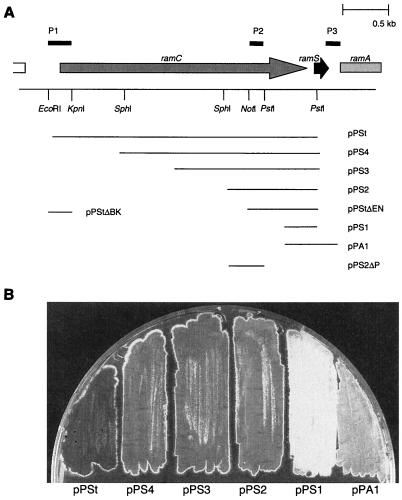FIG. 3.
Promoter-probe analysis of the ramCSAB operon. (A) The various fragments that were amplified by PCR and cloned in front of the promoterless undecylprodigiosin activator gene redD in vector pIJ2587 are indicated by the horizontal lines. These constructs allowed promoter activity to be monitored visually by the red pigment production elicited in host strain S. coelicolor M512 (M145ΔredD actII orfIV). The lines marked P1, P2, and P3 indicate the regions that showed promoter activity. (B) Bottom view of an R2YE plate with S. coelicolor M512 transformants carrying promoter-probe vectors pPSt, pPS4, pPS3, pPS2, pPS1, and pPA1 after 6 days of growth. pPSt elicited a high level of Red production that became apparent after 30 h of growth. The level of Red production induced by pPS4, pPS3, and pPS2 was markedly lower and became apparent upon the onset of formation of aerial hyphae. pPS1 did not induce any Red production. The level of Red production induced by vector pPA1 was extremely low and was only visible after prolonged incubation. The Red production elicited by clones pPS4, pPS3, and pPS2 was similar to that elicited by deletion variants pPS2ΔP and pPStΔEN. The level of Red production of pPStΔBK was identical to that induced by pPSt.

